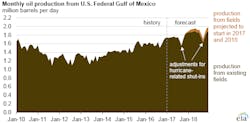EIA expects GoM oil production to keep rising
Offshore staff
WASHINGTON, D.C.–Oil production in the US Gulf of Mexico is expected to continue increasing on an annual basis through 2018, based on forecasts in the US Energy Information Administration’s (EIA) latest Short-Term Energy Outlook.
In January, US crude oil production in the federalGulf of Mexico increased for the fourth consecutive month, reaching 1.7 MMb/d. In 2016, GoM production set an annual high of 1.6 MMb/d, surpassing the previous high set in 2009 by 44,000 b/d, the EIA noted.
In 2016, eight projects came online in the GoM, contributing to the high production levels. Another seven projects are anticipated to come online by the end of 2018. Based on anticipated production levels at these new fields and existing fields, annual crude oil production in the GM is expected to increase to an average of 1.7 MMb/d in 2017 and 1.9 MMb/d in 2018.
Because of the length of time needed to complete large offshore projects, oil production in the GoM is less sensitive to short-term oil price movements than onshore production in the Lower 48 states. The EIA pointed out that recent crude oil price increases have not had a significant impact on operations in the GoM.
Rotary rig counts in the area—including both gas- and oil-directed rigs—have actually declined since crude oil prices increased following the November 2016 Organization for the Petroleum Exporting Countries announcement to cut production.
However, long-term trends also affect GoM oil production, the administration continued. The number of rotary rigs operating in the Gulf decreased from an average of 55 in 2014, when the Brent crude oil spot price began dropping, to 22 in 2016. The number of development and exploratory wells has fallen in each year since 2012.
Although the number of operating rotary rigs in the GoM increased from 2012 to 2014, falling crude oil prices in 2014, along with drilling delays caused by the 2013 discovery of faulty rig safety equipment, led to decreasing drilling activity in that period.
Exploratory wells are favored in the current low-price environment as they allow operators to identify promising areas in the event that oil prices increase.
In recent years, the number of development wells has fallen much faster than the number of exploratory wells. This reflects operators taking advantage of the lower day rates in the current low price environment, with expectations of higher returns when crude oil prices rise and discoveries are brought into production.
Uncertainties in oil markets may still affect long-term planning and operations in the GoM, and the timelines of future projects may change accordingly.
04/12/2017



